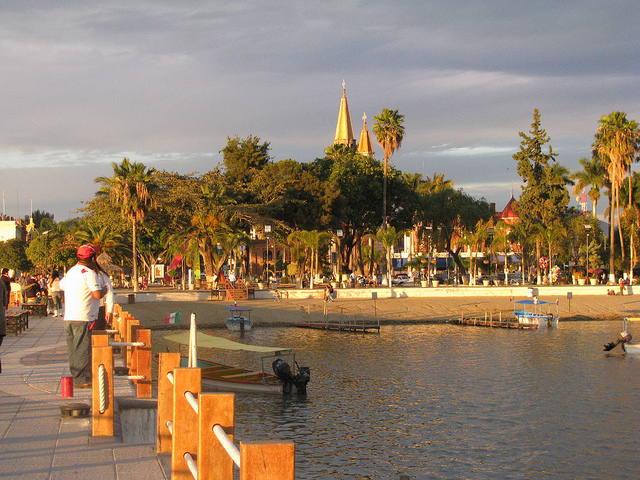My first few hours in Guanajuato had already exposed me to so much of the unique history and architecture of this gorgeous Mexican silver mining town. We had started our tour with a visit to the Boca Mina San Ramon mine and the adjacent exquisitely ornamented baroque Church of La Valenciana. Then we travelled through Guanajuato’s fascinating underground tunnel system to one of the town’s main sights: the huge monument to “El Pípila”, the city’s local hero during the Mexican War of Independence.
After enjoying the sweeping views of the city from the terrace in front of the monument we came back down the mountain, parked the van and started to walk towards Guanajuato’s main square, the Jardín Unión. Surrounded on all sides by restaurants and bars, this triangular square is anchored by neatly trimmed laurel trees and a bandstand. It is a favourite gathering place for the whole town, and in the evening it bustles with mariachis, shoe-shiners and buskers.

Guanajuato’s main square, viewed from the mountain
Across the street clusters of university students were sitting on the stairs of the Teatro Juarez. Sujei explained that on weekends the Church of San Diego at the southern end of the Jardín Unión becomes the departure point for an important local evening ritual: “Las Estudiantinas” are local strolling student minstrel groups that have been filling the narrow streets and alleyways of Guanajuato with music since 1963. Locals and tourists alike join in for a musical walk through the atmospheric corners of the city. The Estudiantinas typically leave from the southern end of the Jardín Unión from about 8 pm.
We were definitely hungry now from all these local explorations so we headed into the Casa Valadez restaurant, at the corner across from the Teatro Juarez. Located in a building that dates back to 1760, this historic restaurant was first opened by the Valadez family in 1930. Major remodeling took place in the 1980s and 1990s and today Casa Valadez presents itself as one of Guanajuato’s top ranked restaurants.

Shoeshiners on the main square of Guanajuato
Our meal was an opportunity for Sujei to give me an introduction to the local cuisine. We started off with an appetizers that consisted of a selection of international breads, accompanied by three sauces: salsa pico de gallo (made of tomatoes, onion, cilantro and lime juice), chimichurri (a combination of chili and mayonnaise), and a salsa verde, actually a dark red sauce made with chilies, green tomatoes, onions and garlic.

Lunch is always colourful in Mexico. I loved these appetizers..
Our culinary tour of Mexico continued with one of my absolute favourites: sopa azteca, a tomato based soup with tortilla chips, chilies, sour cream, cheese and avocado. Roberto continued with an “ensalada Thailandesa”, Thai salad with fruits and vegetables. Our main dishes included Sujei’s fish filet, which was presented on a bed of local vegetables including “jicama”, which translates as “yam bean” and is similar to turnip. Roberto enjoyed “fajitas de pollo”, more of a Tex-Mex creation, while I enjoyed enchiladas, rolled up corn tortilla with a chicken filling and covered with a chili pepper sauce.

Sujei’s fish filet looked delicious
Feeling much better after a good meal we continued our discoveries on foot and stopped at Guanajuato’s Cathedral, the Basilica of Our Lady of Guanajuato. This baroque church was recently repainted with a strong dark yellow and orange colour scheme and is home to a thousand year old statue that was donated by the Spanish King Charles I. In front of the cathedral stretches the serene Plaza de la Paz which also houses the Palacio Legislativo, the legislature of the State of Guanajuato.

The brightly coloured Cathedral of Guanajuato
On the north side of the square we walked through a steep narrow alleyway to reach the University of Guanajuato, an impressive white stone building dating from 1732 that features a long stretch of stairs. From the top I enjoyed a magnificent view over the city. El Pípila was looking at me from the hill across from me.

The University of Guanajuato with its sweeping staircase
Sujei then took me into the interior courtyard of the university, an impressive space, and then past the Jesuit Temple. Historic baroque-era architecture abounds in this part of Guanajuato. On one of the small squares in the downtown area we looked up on the rooftop of a brightly painted house where we saw a tiny Chihuahua dog standing on guard. He was surveying the area attentively. We were just hoping that he would not be audacious enough to jump down. But he made a great mascot for this little square in front of the Bar La Creperie.

We were all hoping that this little guy wouldn’t jump
The afternoon was slowly coming to an end and after an intense day of sightseeing my expert local guides dropped me off at my hotel. I had arranged an interview and tour with the general manager of the hotel. Javier Perez, a dynamic young entrepreneur, graciously told me the story of Quinta Las Acacias. The building dates to 1890 and his father purchased the property in the 1990s but had to restore it from the ground up as the building had stood abandoned for quite some time. In 1998 it opened its doors as a luxurious boutique hotel with 17 completely uniquely decorated rooms and suites.

Javier Perez, manager of the Quinta Las Acacias




